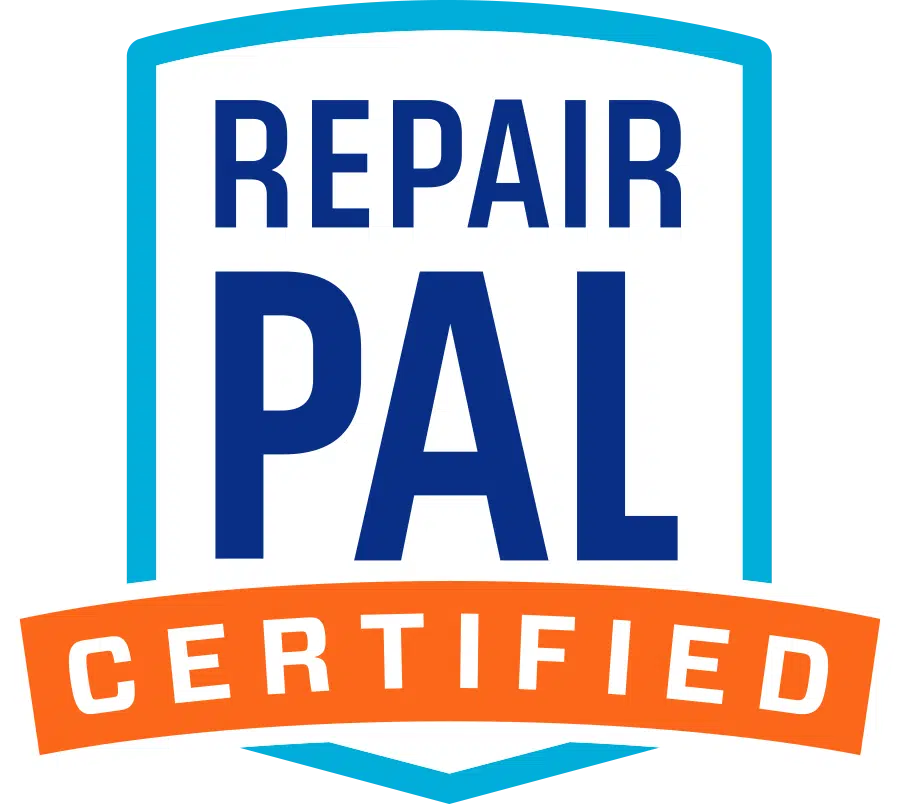What Does Code P0420 Mean?
- P0420 definition: Catalyst system efficiency below threshold (Bank 1)
- Issue Severity: MODERATE – Extended driving with this code can cause internal engine damage.
- Repair Urgency: Get this code fixed as soon as possible to avoid further damage to your emission system and possible engine damage.
- Diagnosis: The most common cause of P0420 is a bad catalytic converter, but it can be caused by anything from a faulty oxygen sensor to a rich or lean running condition, or misfires. There are many variables that could cause this code. To avoid serious engine damage, take your vehicle to a certified shop as soon as possible, or click here to save money by fixing P0420 yourself with FIXD!
- Common Reason: Code P0420 is often related to a bad catalytic converter.
P0420 means the catalytic converter is not efficiently removing pollutants from the exhaust. Your car won’t pass an emissions test. A bad catalytic converter isn’t a hazard to the driver but it can overheat and destroy engine components.
Read more about how catalytic converter problems can hurt your engine here.
Can I Drive With P0420?
Yes, it is usually alright to continue driving in the short term with P0420. It does not pose a risk to the driver. Driving long term with this code can damage your engine and exhaust system. You don’t need to call a tow truck if you see this code, but you should try to diagnose and fix the problem as soon as you can.
You might notice a slight decrease in your car’s performance. This is because your exhaust system is not working at peak efficiency. P0420 can become more serious if there are other codes present that show there is too much fuel in your air/fuel mixture. Check to see if there are other codes like P0171, P0172, P0174, or P0175. These codes can mean that the engine is getting the wrong fuel/air ratio.
Learn more about fuel/air ratios here
How Serious Is P0420?
Code P0420 is not usually a risk for the driver. In most cases the code is not serious enough that you need to stop driving your car immediately. The longer you drive though, the more you damage your engine and exhaust systems. Diagnose and fix this code as soon as you can.
How Hard Is It To Fix P0420?
It depends on what is causing the P0420. A lot of the repairs for P0420 can be done at home. Some of the simpler repairs can be as easy as replacing an O2 sensor or some broken wiring or connectors. Other repairs are more complicated and you might need to take your car to a mechanic.
Can I Fix P0420 Myself?
Yes, you may be able to fix P0420 yourself. Depending on the cause of the code, the diagnosis and the repair might be simple or might be very difficult to do at home. You might need access to a welder if you need to patch an exhaust leak. You might also cause more damage trying to repair your problem.
You can use an OBD2 scanner like FIXD to see if you even have a real problem. You can also use an OBD2 scanner to see if there are other codes present that might be the cause of the P0420 code. The FIXD scanner also has a live data feature that lets you see real time sensor data from your car that can help you diagnose P0420 at home.
| Cause | Repair | DIY Or Mechanic | Resources |
|---|---|---|---|
| Misfire (p0300, p0301, p0302, etc.) | This repair could be as easy as changing a spark plug or as hard as fixing a cylinder head gasket | Many of the possible repairs are possible at home. See if you can rule out a harder repair before taking it to a mechanic. | P0300 Engine Code Explained: Causes, Symptoms & How To Fix It |
| Air/Fuel mixture is lean or rich (p0171 or p0172) | This repair can be as easy as cleaning the Mass Airflow Sensor or as hard as complicated exhaust repair. | Many of the possible repairs are possible at home. See if you can rule out a harder repair before taking it to a mechanic. | P0171 – Meaning, Causes, Symptoms, & Fixes P0172 – Meaning, Causes, Symptoms, & Fixes |
| Exhaust leak | Patch the damaged areas or replace parts | You can do this at home especially if you weld. There are no-weld solutions too | How to Repair an Exhaust Leak DIY (No Welding) |
| Broken or damaged oxygen sensor | Replace the oxygen sensor | You can try this at home | https://www.fixdapp.com/blog/how-to-replace-an-oxygen-sensor/ |
| Damaged wiring or connectors | Replace the damaged wiring or connectors | You can try this at home | O2 sensor wire repair |
| Broken or worn catalytic converter | Replace the catalytic converter | This is easier with a direct-fit bolt-on catalytic converter. It’s harder with a universal-fit catalytic converter as it needs to be welded. | How to Replace Catalytic Converter in Your Car |
How Do I Fix Code P0420?
You can fix P0420 at home. Before you fix P0420 though, make sure you correctly diagnose the cause of the code first. If you don’t, you could end up spending $1000s buying a new catalytic converter when that wasn’t the cause of the code.
If there are exhaust leaks or damage you will have to patch or repair them. If the damage isn’t severe, you can fix it by welding. If you don’t have a welder or don’t know how to weld, you can take your car to a repair shop for them to fix. If the damage is more severe, you might have to replace whole parts of your exhaust system.
If there is damage to one or both of the O2 sensors, the wiring, or connectors, you should replace the damaged components.
If you find that the catalytic converter is broken or the catalyst is worn, you will need to replace the catalytic converter.
Once you’ve fixed the problem make sure to clear the P0420 code and drive for about 15 minutes to see if the code returns. If it returns, you have not fixed the problem.
You can clear the P0420 code with the FIXD sensor.
What Causes P0420?
The most common reason for code P0420 is catalytic converter failure. There are other potential causes for this code though. It’s important to look for other codes that could explain why the converter failed. Misfires or an incorrect air-fuel ratio could be the causes of a failed converter.
Misfires can be the cause of a failed catalytic converter. Look for the following codes to see if a misfire happened
An incorrect air to fuel ratio could also cause a catalytic converter failure. Lean means there is not enough fuel in the ratio and rich means there is too much fuel. Look for the following codes to see if your engine is running rich or lean
The most likely cause of a P0420 code depends on your car’s model and age. Use FIXD’s tool to see what the most likely cause of this error code is for your specific car.
Other possible causes are:
- Worn or internally failing catalytic converter (Most Common)
- Faulty oxygen sensor
- Faulty air-fuel sensor
- A leak in the exhaust system
- Misfire (the root cause of converter failure)
- Rich or Lean air-fuel ratio (the root cause of converter failure)
- Leaded Gasoline (the root cause of converter failure)
How To Diagnose P0420
There are four major things to check when diagnosing P0420:
- Make sure there are no other codes present
- Check if the code was random by clearing the code and driving to see if it turns on again
- Check the exhaust system for leaks
- Check the downstream O2 sensor to see if the catalytic converter needs to be replaced
Make sure it’s the only code
If there are other codes you need to address them first because they could be the cause of the p0420 code. You can use an OBD2 scanner like FIXD to see if there are other codes present. If there are other codes present like P0300 or P0171 they could be the source of the problem. Do not replace your catalytic converter without fixing these codes first. If you replace the catalytic converter without repairing the other code, the new catalytic converter will go bad again.
Check to see if the code remains after clearing and driving
Sometimes the sensors in your car can detect unexpected patterns. If this happens long term, this means there is either something wrong with the car or the sensor and your check engine light will turn on. If it happens for a short period of time, your check engine light can still turn on even if the problem goes away. You should try turning your check engine light off and driving for about 15 minutes to see if it returns. If it doesn’t turn back on, this likely means there was a short term problem that you don’t need to address.
Be careful though. If the check engine light does come back on soon after turning it off with the same code, it’s likely the problem is real. You will need to diagnose and fix the problem.
You can turn your check engine light off with the FIXD sensor.
Check the exhaust system before the catalytic converter to see if there is any damage
If P0420 returns after a cycle of clearing the code and driving, you should inspect the exhaust system. Look at the exhaust system, especially upstream of the catalytic converter. Check for rust, holes, and leaks. Make sure to check the exhaust manifold, gaskets, and exhaust pipes. If you find any damage or leaks, you need to patch them.
If there are no leaks check the downstream O2 sensor
Start your car and make sure it’s at a normal operating temperature. Use the FIXD live data feature or a digital multimeter to check the voltage of the downstream O2 sensor. When the catalytic converter is working, the downstream O2 sensor should be at about 0.45 volts.

You need to replace the catalytic converter if the voltage is jumping between 0.1 and 0.9 volts. This means that the catalyst in the catalytic converter is worn out.
What Are The Symptoms Of P0420?
When you have a P0420 code you may notice the following:
- The check engine light is on
- A lack of power from the engine
- Decreased fuel efficiency
- Rotten egg or sulfur smell
The reason you may smell rotten eggs is because there is a small amount of hydrogen sulfide in the fuel. Hydrogen sulfide is what gives rotten eggs their smell. A working catalytic converter should convert hydrogen sulfide into odorless sulfur dioxide. When the catalytic converter breaks, it might not do this anymore. When this happens your exhaust emits hydrogen sulfide and you smell rotten eggs.
How to Fix Code P0420
- What to do if you have a misfire code (p0300, p0301, p0302, etc.)
- What to do if Air/Fuel mixture is lean or rich (p0171 or p0172)
- How to fix exhaust leak
- How to fix broken or damaged oxygen sensor
- How to fix damaged wiring or connectors
- How to fix broken or worn catalytic converter
How Much Does It Cost to Have Code P0420 fixed?
Fixing P0420 can cost anywhere between $0-$2400 depending on what the cause is. Below are the cost ranges of having a mechanic fix common repairs:
- Air fuel sensor $200-$300
- Oxygen sensor replacement $275-$500
- Catalytic converter $400-$2400
- A leak in exhaust $100-$200 (if welded to repair)
It will be much cheaper if you do it yourself, but you risk causing more damage if you are not experienced.
Before trying to fix P0420 make sure you correctly diagnose the cause of the code. If you clear the code and it doesn’t come back after driving, you don’t have to spend any money on it. If there is a small leak in the exhaust system that you can weld, you won’t have to spend much money on the repair. On the other hand, if you need to replace the catalytic converter, it is going to be an expensive repair.
We recommend using our OBD2 Code Cost Estimator to get an idea of how much it will cost to fix the issue. This tool can help you make an informed decision and avoid overpaying for repairs.
Cost Of Catalytic Converter
Between $400-$2400 depending on the type. A direct fit catalytic converter (made for your specific model) is expensive but easy to install. A universal catalytic converter (fits a wide range of cars) is cheaper but needs welding. Some states have strict emissions laws that require more expensive catalytic converters.
A direct fit catalytic converter is one that’s made specifically to fit your exact model. If you use this type make sure to get one made for your exact car. You should be able to unbolt your old catalytic converter and bolt in the new one relatively easily. They are more expensive to buy because they only fit one unique model. You can save money by installing it yourself or get it done at a repair shop. Because it’s so easy to install, most of the cost is going to be for the parts.
A universal fit catalytic converter is made for a wide range of models. Not every universal fit catalytic converter will fit every vehicle. Make sure you get one that fits your vehicle. Since these are not made to fit a specific model you will need to install this part by cutting a section of your exhaust out and welding the new part in. While universal fit catalytic converters are cheaper, they are harder to install. If you have a mechanic install it for you, there will be more labor costs because of this. If you are more experienced this would be a good way to save money.
All cars are required to have catalytic converters that meet EPA emissions standards. Some states require cars in their state to meet the stricter CARB-compliant catalytic converters. Because of the stricter standards, these catalytic converters usually cost more. States that require CARB-compliant catalytic converters are:
- California (all years)
- Colorado (all years)
- New York (1993 and newer except 1995)
- Maine (2001 and newer)
You can find used catalytic converters for cheaper. The risk of using a used catalytic converter is it might not be in great condition. This means you might have to buy another one soon after replacing the first one.
What is a catalytic converter?
Your catalytic converter is part of the exhaust. It is between your engine and muffler. When your engine is running, it produces harmful pollutants like carbon monoxide. Your catalytic converter breaks down these pollutants into less harmful gasses.
Code P0420 indicates that the catalytic converter is not functioning efficiently, and is increasing the output of harmful pollutants by the vehicle.
Read our article on what a catalytic converter is and how it works
What are O2 Sensors?
Most vehicles have two oxygen sensors (O2 sensors). One sensor is upstream of the catalytic converter and the other is downstream. These sensors help your car figure out how to balance the air to fuel ratio. It is a problem if the O2 sensors have the same reading. This is because it’s the catalytic converter’s job to reduce pollutants. If the exhaust is the same before and after the catalytic converter, it isn’t doing its job.
Your O2 sensors communicate with the Powertrain Control Module (PCM). When the O2 sensors send unexpected readings to the PCM, the PCM can trigger a P0420 code. There are many reasons the O2 sensors can send unexpected readings to the PCM. This can make diagnosis tricky.
Fixed It But The Check Engine Light Is Still On?
Check engine light sometimes need to be reset manually, check out our article:
How to Reset Your Check Engine Light | 4 Ways To Clear It (With or Without a Scanner)

At FIXD, our mission is to make car ownership as simple, easy, and affordable as possible. Our research team utilizes the latest automotive data and insights to create tools and resources that help drivers get peace of mind and save money over the life of their car.















119 Responses
Brand new catalytic converter, new injectors and still getting the 420 code showing bank 1 sensor I ordered a new one of those but not sure it’s going to solve the problem! Any Suggestions????
I have a 2013 Chevy Cruze. Code P0420. None of the symptoms nor engine light. My coolant keeps disappearing. Idk where it’s going.
Some days it’s a rough idle when first turned on, assuming it’s starter… What do you think? Replaced thermostat, water pump, and radiator..
How to use on other car
I have a 2012 chevy cruze 1.8 eco. That i just put a new to me motor in bc it got hot smoked the head gasket and threw the timing belt in all one fluid motion while driving 65 down the interstate. Now that motor didn’t have a P0420 code but about a month later after having the motor replaced the CEL came one, just hoping it wasn’t the same PVC issue I had with the old motor which it wasn’t. Car ran fine even with the light until 2 nights ago I was taking this older gentleman home from our work. And about 15 mins into my drive mind you im doing the speed limit of 55 when it starts bucking I back off the throttle get back into and something. Kicked in neutral and coasted for a lil while, started the car back up and no issues until I’m on my way home my car won’t let me go faster that 45. But my wife gets in it to go to work yesterday and has no problems what so ever. She drops the car back off with me at work and I take her home which was a 10pm now when I got off work about 7 hours later. The car did its cold start revs, but once it kicked down to normal running rpm which is and 700 to 800 rpms. Now it fluctuating in between 500 and 700 and when it does I can feel it in the driver seat pulsating. When I go to slowly Rev the car you can literally feel it almost acting like it’s killing a cylinder but you get past 2k without a load just fine luckily I only had to drive a few blocks but it was bucking and jerking in the same fashion it was 2 days ago. Got it home let I idle for a lil bit and then the intermitten(almost like the car has a big vacuum leak again) jumps and skips. Shut the car off for maybe 10 seconds started it back up and no hesitate jump or miss. Ik I’m not going to leave it at that. And as I still on a ish ton on this car I am not able to just get out from underneath and not to mention it has became my wife’s daily. And being from Southern illinois I’m not exactly made of money as it took my 2 months to save enough to pay 1500 for a motor and someone to put it in. I’m having these same issues and she’s wanting to go to Kentucky today with the car. Also I just had the oil changed 3 days ago if that means anything. And I always get gas and the same station in the same town. About to call my local muffler shop and see if they can just put a new exhaust resignator and cats on it. And then go from there bc even though it’s located literally right on the side of the motor I honestly don’t feel like dropping more money into. It’s a 2012 chevy cruze 1.8L Eco body has 157xxx on it and the motor has 145xxx on it now. Now I’m no Aaron Kaufman or anything but I’m no average Joe when it comes to mechanical work. And they fact that you need and sensor for a sensor so this relay to can tell this fuse to go f off. Is insane and absolutely mind blowing. Why can’t we go back to mechanical fuel pumps, distributors or even a 750cfm double pump quardrajet holley carb for crying out loud. Well I’m just a 31 yr old man rambling now. But would sure appreciate some feed back on this as to I need to start planning my attack for the day being as the wife wants to be on the road by 10
I have replaced both o2 censors on my 02 Camry no check engine light is on but still telling me that it is the problem don’t know what to do
Check the coils. I have an ’06 Dodge Dakota that was getting P0420 codes. I found the spring inside the #1 coil had disintegrated, causing a weak spark and a rich fuel mixture in that cylinder.
Can a bad catalytic converter after having put a hole in it to unblock it cause your air conditioner to turn off while driving the car ? Then after shutting the car off for while and starting the car again the air conditioner will work again.
2013 Chevy Equinox FWD. Just drove 1300 miles from Cal to Washington . Vehicle has 78,000 miles on it. Running fine, no issues great gas mileage 28-30 mpg. Car had California Smog test about 4 months ago and tested fine. Today while driving check engine light popped on, no other indication of any problems. Pulled over, and ran a FIXD diagnosis and P0420 was code. No suffer smell or rough running. Checked gas cap and it was not fully to lock (clicked) position. Secured it and reset engine light and so far it has not returned. Could not having gas cap secure account for this reading or do I need to go to the dealer. Catalytic Converter is supposed to be covered repair under warranty for 100K as I recollect will check manual in the AM before going to dealer if light comes on again.. If I keep driving for awhile with no other symptoms and check engine light does not return am I likely in the clear? I seem to recall that if gas cap not secure that can effect emissions.
2014 Chevy Cruze p0420 code keeps coming back on I just had catytic converter put on. 02 sensor are good so what bow
You are an awesome tribute
Can a P0420 (bank 1) be caused by the downstream 02 sensor (bank 2), or is it only for upstream (bank 1)?
I have a subaru forester 2007 non turbo that has a CEL for P0420 (bank 1). I’ve used a OBDII scanner, and it shows that the short term fuel and long term fuel trim in bank 1 are ok, but shows a result of 0 for bank 2. Is it possible that the downstream sensor is at fault? Even when the OBDII scanner says bank 1?
You should have been resetting the check engine light while making those repairs, but if you didn’t, go ahead and reset it with a FIXD Sensor or by disconnecting the car battery for about 10 minutes and then run the car for 50 to 100 miles. If the light comes back, check your codes again, if it doesn’t come back, the problem is fixed and your scanner should read Ready.
Has your AC has been recharged in the last 24 hours? Is so you may get one P0420 on the next startup. The gas is heavier than air, gets sucked into the intake manifold .. and fools the O2 sensor into believing the catalyst has failed.
Reset the MIL and the problem will not recur.
I had the P0420 code pop up a while ago. I changed the downstream O2 sensor, which didn’t solve my issue. A few days ago I changed the bank 1 catalytic converter. When I turned the car on and ran a scan the P0420 code along with 5 out of 6 cylinders showing a misfire. I also saw the sensor needed calibration, which I did. The misfires didn’t return but after I cleared the P0420 code it returned a couple days later. I guess my next moves are to change the upstream O2 sensor and/or checking the new catalytic converter for a leak because it was a pain in the neck to install.
code p0420 Three months ago light came on and i replaced the o2 sensor and light went off for 3 months. It has now come back on with the same p0420 code. I did not replace the a-f sensor where is it located and what are my options?
I found the info quite useful but would like to explore much more.
Does anyone know of code P420 on a Tacoma can be fixed with gas cap replacement?
FYI, never had an error code before until I added a fuel treatment from Lucas. The engine ran fine, no problems until the engine light came on sometime after adding the treatment. Cleared the code and it has not come back since, but I haven’t added anymore fuel treatment either. The fuel treatment has not made any of my other cars engine lights come on, just my GMC Sierra 1500.
You didn’t say which code you got, what year, or how much mileage. It’s possible that the treatment dislodged some gum- AKA “crud” that deposited itself on a spark plug or the O² sensor. Many times this deposit will burn off and not be a problem afterwards.
My 2003 Chevy Avalanche is throwing both P0420 and P0430. With the advanced troubleshooting on the FIXD it is telling me that the evap system is failing. I have replaced the vent valve and the purge valve and the gas cap. What should I look at next?
My FIXD is showing a problem with the catalytic converter (Bank 1). At the dealership they verified the issue. However I got that converter replaced last October at a garage in my town. I cleared the check engine light and 3 days later it came back on. Guess I have to take it back to the garage where I had it worked on last year. SIGH!!!
Have P0430 and the car with skid marks warning. I just took my SUV out of shop to get rebuilt transmission. Could these warnings have anything to do with rebuilt transmission?
I replaced the upstream O2 sensor on my 2010 Chevy Aveo, but still have the CEL and P0420. Would not replacing the downstream cause this?
Possibly. It’s also as likely that you simply have a bad distributor cap, or a coil pack that’s got a weak output. Even a spark plug that’s worn can cause this code. Many times you can see it on the “Live Data” of the fix’d app. This is especially true if it happens most often after driving in the rain. Moisture can get into the distributor or the coil pack and cause an erratic spark or signal. Check those! Loose exhaust connections can be tricky to find, but at idle often sound like a chick- chick- chick- sound. The reason for this isn’t that the exhaust comes out, but that between each cylinder’s individual exhaust there’s a slight vacuum created that draws in air and throws all the readings off, causing the computer to set the code.
Wow that is great. I had a P0300 P0301 P0304 all mis fire. Then driving in rain threw P0420. So just what you said. So what is it just coil pack? I just bought new plugs and coils. So what is it?
I have a 08 Chevy Silverado v8 I have 4 O2 sensors which one would be Bank #1 if someone could help me out with this question be much appreciated. Thanks
Bank 1 is drivers side. Upstream is before the catalytic converter. Downstream is after the catalytic converter. Bank 2 is passenger side. Upstream is before the catalytic converter. Downstream is after the catalytic converter.
I have a 2007 Nissan Xterra, only code it’s showing is P0420 catalyst system efficiency below threshold bank 1. Did some research and some people are saying it’s the catalytic converter is bad. Any ideas?
Witch side is bank 1 on a Nissan Extera
For this code p0420 if I wanna fix it, by priority, which one should we fix and replace: oxygen sensor or whole cat?
I have a 2006 VW Jetta 2.5L with CEL on. The code is P0420. I did a temp reading at Cat Converter. The exhaust side is 150+ higher in temp. There are no other codes attached. Any Idea?
When I scan the 2005 GMC Safari, with “live gauges”, the #2 and #5 O2 sensors (One is upstream, the other down) are jumping all over the place and it sets a ‘420’ code about once every 2 or 3 weeks. Bad O2 sensor? A weak spark plug? Thoughts?
Would you recommend trying a catalytic converter fuel and exhaust system cleaner to address a P0420 fault? If so, what is a good product/brand to use?
My catalytic converter pass state inspection but it’s say p0420 bank 1 because of it my service light won’t turn off I also been told that my service light and check engine light are different
Hey Jeffry! The check engine light typically means there is something wrong with your vehicle, while the service light can simply mean it is time to have your car serviced (i.e. get oil changed or rotate tires).
FIXD Team
where is the downstream O2 sensor located in the 2007 Honda Accord. I need to measure
the voltage reading of the downstream O2 sensor.
The downstream O2 sensor should be located post-catalytic converter.
Where would the catalytic converter bank 1 be on a 2006 Chrysler Sebring convertible?
Would a modified exhaust system cause a P0420 Code? For example a “Cat-less” Exhaust System that is not OEM but all direct bolt on (no welding).
This is for a 2000 Subaru Impreza 2.5RS – Manual. Exhaust System: Spec-D Headers (Heat Wrapped), Stromung Catalytic Eliminator Front Pipe with Bosch Upstream and Downstream O2 Sensors, Borla Intermediate Pipe and Muffler. All installed on 3/18 including Gaskets.
The reason I ask this question is because with this type of Exhaust System, I am getting that code P0420. All brand new parts, all installed at the same time, all with new gaskets, and with the bolts torqued to spec. So that would eliminate “leaks” as the cause. The O2 sensors were also installed at the same time. So that would eliminate “bad O2 sensors” as the cause. Now for the Catalytic Converter…there is really none to speak of because of the Stromung Catalytic Eliminator Front Pipe 1999-2005 Impreza Non Turbo I also installed at the same time. It is a direct bolt on replacement piping, specifically designed to replace the catalytic converter. Were I live there is no emission’s restrictions/requirements and I mainly use it for off road use (track car).
So is that the reason why I am getting that code? The only other thing I can think of is the wiring because of the year and age. Any ideas would be greatly appreciated and thank you for reading my novel 😉
I don’t know if you ever solved this issue, but for you and all our readers,; you have to keep in mind that without a cat, you’ll get basically the same signals as the upstream sensors. The computer sees this as a failed cat and sets a P0420 code. What the computer wants to see is an almost steady signal of around 0.45 volts. While some computers can be ‘fooled’, most are set up to set an error code if you attempt to circumvent the downstream sensor. Doesn’t hurt to try!! Good luck.
I put my Bank 1 Sensor 1 O2 sensor on yesterday and today engine light came back on and I did a reading and it say P0420 catalyst system efficiency below threshold bank 1. Can anyone tell me what it could be
Oi Bom dia estou com o cod P0420 ativo na minha XC60 2011 e tambem esta ativo o cod P0171.
Alguma dica.
Hello! My check engine light (solid) and cruise control (blinking). FIXD code detected was P0442 – Evaporative emission control system leak. I had FIXD clear the code prior to taking my 2005 Subaru Forester to a mechanic. The engine light and cruise control lights went out. Today a week later, the lights are back on. I used FIXD and Code P0420 – Catalyst System Efficiency was detected. I’m assuming that by not addressing PO442 code it lead to Code P0420?
I have a 2009 Suzuki SX4 with a code P0420 and I am trying to figure out which one to change can you help me please
I want to find out if it is bank 1 or 2 censor up stream or down stream
I have replaced the catalytic converter twice and still have the same problem
Hi Carlos,
The catalytic converter is only one of the things that could be problematic in trouble code P0420. Please do not overlook other tests and possible errors that it could be!
Thank you,
The FIXD Team
Thanks. I understand the code much better now.
I just replaced both 02 sensors in 2002 Yukon XL 1500 car seem like it was fixed then it shutoff same issue persists what else could it be ?
I recently purchased a used 2008 Saturn Vue and my check engine light is on and showing code P0420 catalystic system failure because of an exhaust leak, where would I find my exhaust and what am I looking for? ( I am a young female and know nothing about cars )
Hi!
You will have to reference your car specific service manual to locate your exhaust and other car parts located under the hood.
The FIXD Team
I have a 2002 PT Cruiser, there is only 1 O2 sensor and I have changed it to no avail. Any suggestions on what to try and/or how to diagnose the issue?
Hi Bob,
Check to make sure that the readings with your multimeter are correct. This will verify that your catalytic converter is functioning properly. If this does not fix the issue, contact our Mechanic Hotline to gain more insight!
I replaced the engine in my 95 Ford Mustang. With the higher compression from the engine pushing out old carbon build up, I received this fault code.. 1 can of Sea Foam cleared it up. I had to reset the computer 4 times.. thanks to Fixd.. quick and easy to do.. car is running like a champ.
Hi Frank, thanks for sharing your success with us! That is awesome!
I have FIXD and I got P0420 with Check engine light, VSC and Trac Off lights on the dash board. What is the relationship between P0420 and the VSC and Trac off? why are all three warning lights come on. I reset them with my FIXD, the lights go away but they appear after less than 100 miles. I noticed also when I turn teh ignition key on without starting the car, there is a hissing and clicking sound coming from behind the brake reservoir. How do all these problems combine to give this P0420?
Hello Emilio! We are sorry about the troubles you are having with your vehicle. I passed this along to our team and they said they would go through the diagnosis for P0420, fix it, and then see if the the VSC/Trac Off lights go off.
Hi Emilio,
Our team did some more research and found that if your catalytic converter is severely clogged, it could restrict the exhaust which would impact the calculation of engine load, thus causing the VSC and Trac Off systems to stop working. Please let us know if this helps!
So I’m not sure what’s going on with mine, it’s the same code but for some reason my check engine light will turn off by itself but then a few weeks later it comes back on with the same code. The oxygen sensor has been replaced twice, I have no leaks, the only thing I haven’t done is replace the catalytic converter itself, but I checked the downstream o2 sensor and it’s reading 0.45v it’s just driving me nuts that the light won’t stay off
Used a gas treatment, light out after 16 gal. Time will tell if this fixes the problem
.
Good luck, Glenn! Please let us know if it does!
I have a 2002 PT Cruiser getting this error. It has only one oxygen sensor an it is upstream of the converter. How do I voltage test the O2 sensor (BTW I replaced the sensor and I still get the error).
Manifold leak fixed but light keeps turning on. Not worth $1,500 for new cat. Light stays off sometimes weeks, sometimes less sometimes more.
Try a local muffler shop. Mine had generic (universal?) catalytic converter for about $300, installed.
Would you happen to know where I can put my multimeter to test the voltage? Is it on the o2 sensor or the connector?
Hi Enrique! You connect the red probe to the signal wire, and the black probe to a ground. We are working on producing how-to’s with this information, but in the meantime, we found this to be very helpful: https://axleaddict.com/auto-repair/How-to-Check-an-Oxygen-Sensor
p1272 code
replaced the following on a 2005 Altima. both up and downstream sensors, and the exhaust manifold with catylitic coverter also replaced MAF sensor and the fuel pump reset the code day later thecode came back. it said engine running too lean the only thing I didn’t replace is the throttle body
any suggestion, i
I have a 2005 Nissan Altima with code p1272 . which I’m told is running too lean I replaces the exhaust manifold w/caty convertor. also replaced both up and down stream 02 sensors , MAF sensor and the fuel pump, cleared the codes with FIXD day later same code came back the only thing I didn’t replace is the throttle body fuel has a internal filter. so I thought the fuel pump pressure might be the cause. any suggestions.
Pvc valve replaced?
Hi! Thank you for reaching out. Codes that start with P1 are manufacturer specific. Could you please provide us with your year, make, and model and we will look into it!
Lean means not enough gas in the fuel mixture. Could be fuel pump or fuel filter
Worked like charm
Thank you this was very helpful understanding how things work.
Hi Leon! Thank you for the feedback, it really means a lot to us!
Thank you for sharing, it was very informative and somewhat a relief from worrying.
I USED A FIXD DIAGNOSTIC READER, AND MOST CODES ARE ACCURATE, I LIKE WORKING ON CARS,,BUT IT WOULD BE NICE AND FIXD WOULD BE MUCH HELPFUL IF IT WOULD SHOW YOU A EASY PICTURE DIAGRAM OF WHERE THE BROKEN PART IS LOCATED,,EXAMPLE : WHERE IS P0420 BANK 1 LOCATED ON YOUR VEHICLE ?
Now that is a great question, Armando
I had a new catalytic converter put in the automobile. I have taken it to the garage prior to purchasing the FIXD product. Garage said that the test they ran says their is a short somewhere and that is what is causing the error message. Converter is working fine according to mechanics. To find the short, they said that they would have to test virtually every wire around the engine, and the labor to find the short could cost hundreds of dollars. Rather than pay 100’s of dollars strictly in labor costs, I have chosen to ignore the engine light. Interestingly, after I use the Fixd to diagnose the engine, it then resets the engine light to off. Usually within a short time, or a few miles of driving, the check engine light comes back on. And your recommendation is ?????
Hi Mike! If the car’s engine control module recognizes a fault after the check engine light is reset, it will cause the check engine light to come back on.
How do we fix the engine control module? Mine is doing the same as Mike’s. I have replaced all the sensors and a new catalytic converter.
where is the camshaft position sensor bank 1 located in the 2011 jeep grand cherokee
Hi! It looks like it should be above the water pump and behind the accessory belt. We highly recommend getting a vehicle specific repair manual that provides diagrams of all of this, such as https://www.amazon.com/Jeep-Grand-Cherokee-Gasoline-engines/dp/1620921073/ref=sr_1_1?ie=UTF8&fixd_blog-20&qid=1523413703&sr=8-1&keywords=2011+jeep+grand+cherokee+repair+manual
I changed the crankshaft sensor the catalyst system efficiency below threshold b1 show up the engine light went off. Do I need to change catalyst converted to
This was very informative!
Bank1, sensor 1 was replaced on the 7th of April. Electronic load detector was replaced about 2 weeks ago. These two things were detected by my cousin’s FIXD device. I did the ELD
myself a friend with a lift did the sensor.
Hi William! Thank you for sharing your experience with us! We really appreciate the feedback!
I went through a huge puddle of water after that check engine light came on. We tested it and p0420 code came up.we cleared the code no return of check engine light. What was the problem the water shocked the cat and sent a signal? Need an opinion
No
Live in a cold climate and noticed that when extremely cold that this code comes up. Is there need to worry? It has come on and off.
Not to worry unless the CEL stays On.
Cold weather brings out the Gremlins in the 1st gen Tacoma, lol
Everybody has them!
Both my vehicles one a 2003 GMC Envoy SLT and 2009 Nissan Murano SL. Have the infamous P0420 Code.
I want to know what kind of money iam looking at. To late for the GMC but my recent car that I got on April 16, 2019 two days later the code pops up
What’s up with that.
The seller probably cleared the code just before the sale, and it took 2 days to reappear.
I had went to put the Catalyst converter so why is it showing up if it was done just my check engine is on that’s what’s the problem yes I like to get it fixed
Can the converter be bad and not have any of the symptoms listed? I’m getting the cose but no issues with rotten egg smell, gas mileage is same as before…etc.
Shannon, if you arent getting the code yet, i strongly suggest adding cataclean or some kind of cleaner, (CRC guarantee too pass is good as well) while you still can. Once it’s completely clogged, the cost can be astronomical. (for my 2011 JEEP LIBERTY its $2400 to replace) and only $200 of that is labor. Some states (NY being one) enforce what’s called the “California emissions” requirement, which means you can only use the converters supplied by the dealer, and designed to pass California emissions.
What is the actual cost of a catalytic converter that the suggested parts and repair is estimated btw $1500 & $2000?
I just did mine, 08 Malibu. Paid $100 for the part on Amazon and $250 to install… Was quoted much higher.
Reason is because this is a general cost if you’re having the garage purchase and install. Also keep in mind that more states are going to California emissions which is quite pricey which is rather inflated pricing and dealer only for emissions parts
I get all my parts from rockauto.com. I only paid not even $280 for bank 1 cat and four 02sensors.
You might also want to look on carparts. Com. Alot of their parts are a little less expensive
Look on card to look for parts
Yes I did know you had trained service professionals who could assist me with advice.
Good morning sir, pls I want know more about the fuel consumption in a particular vehicle what cant be the cause of that after putting all the catalyst and oxygen sensor
Very good information . I’m very grateful .7
Hi,
I just got my Bank 2 catalytic converter replaced in April so I would pass emissions and now my bank 1 catalytic converter is out? Is that possible? Should I have changed all together if this was going to happen?
How do I find the videos on fixing the car it shows the parts
I always buy my parts and labor is cheep where I’m at in ky it’s 70 to 75 an hour I get most of my parts at carid.com there a great place even have dealer parts also
Awesome tool
Don’t forget to take the old one to the scrap yard to get $50. For the precious metals inside
Where Can you find bank one on the catalysti converter
Where can I find bank 1 on 2003 Honda accord ex
Is it worth it changing the catalytic converter on 2005 Toyota Camry
I have a 2007 Nissan Maxima. I have a p0420 code. I just replaced the bank 1 catalytic converter and both O2 sensors and both Cam shaft position sensors. I thought the problem was fixed but after performing along test drive, I am getting hesitation when I try to accelerate from a dead stop and the code returned along with the check engine light. Once it gets passed 2000 rpm and in second gear it accelerates like normal. This hesitation only seems to be present after the engine warms up. It didn’t happen until the end of a 40 mile test drive at highway speed. Any ideas?
I need some help. I have a 2007 GMC Acadia. The engine light is on with a P0420 code. This is what has been replaced/repaired
1. Mass airflow sensor
2. Throttle body
3. Valve covers/gaskets
4. 2 upstream O2 sensors & 1 downstream sensor.
5 . catalytic converter has been replaced twice
All of this and the light is still on. Can some one please give me some advice on what to do now. I don’t know if it is part of it, but the evap code always comes on & won’t reset. Please help!
Based on the instructions given here, you need to concentrate on that EVAP code before worrying about the P0420 code. This code has shown up on my Envoy and what the EVAP is or what the EVAP problem is -that the only one I haven’t figured out yet concerning this problem.
Evap Code most likely is you need to get a new gas cap. Also, make sure the area around the gas cap is free of rust etc.. Hope this helps, so many times people go through so much when it’s just the gas cap.
Spray some wd40 in the back of the engine while its running. If it starts to die down or shut off, you have a vacuum leak
i have a 2004 Z06 and removed the secondary air pump along with all the tubing which supplies fresh air into the headers for cold starts during only the first 3-4 minutes and after 2 years im guessing the ECM doesnt know its missing cause its been running like new since then with no issues